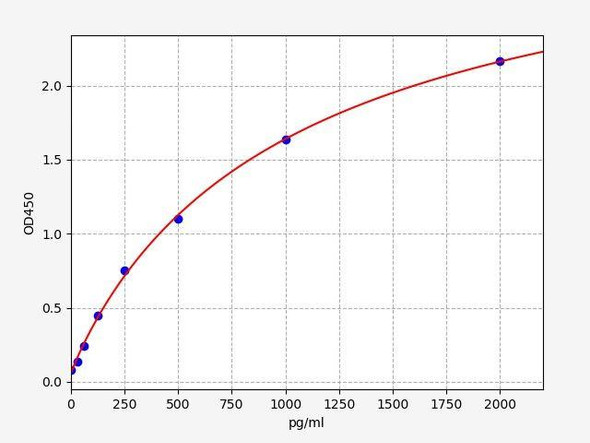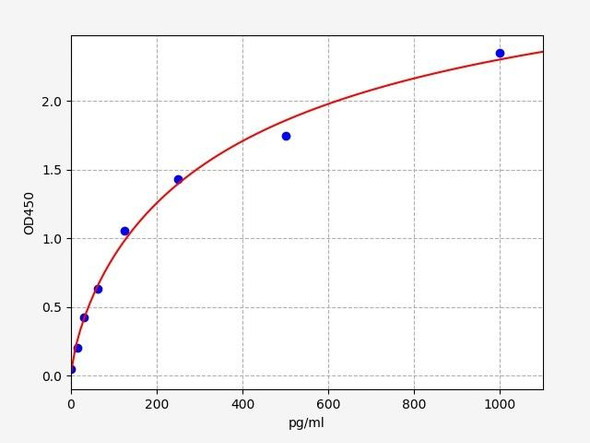Description
Human CBS ELISA Kit
The Human CBS (Cystathionine Beta-Synthase) ELISA Kit is a valuable tool for the precise measurement of CBS levels in human biological samples including serum, plasma, and cell culture supernatants. With its exceptional sensitivity and specificity, this kit guarantees accurate and consistent results, making it suitable for a diverse range of research purposes.CBS is an essential enzyme involved in the metabolism of sulfur-containing amino acids, playing a critical role in the synthesis of cysteine and hydrogen sulfide.
Dysregulation of CBS activity has been linked to various medical conditions such as homocystinuria and cardiovascular diseases, highlighting the significance of CBS as a biomarker for these disorders. By utilizing the Human CBS ELISA Kit, researchers can gain valuable insights into the role of CBS in disease pathogenesis and potential therapeutic strategies.
| Product Name: | Human CBS ELISA Kit |
| Product Code: | HUFI01697 |
| Size: | 96 Assays |
| Alias: | CBS, Cystathionine beta-synthase, Beta-thionase, Serine sulfhydrase, HIP4 |
| Detection method: | Sandwich ELISA, Double Antibody |
| Application: | This immunoassay kit allows for the in vitro quantitative determination of Human CBS concentrations in serum plasma and other biological fluids. |
| Sensitivity: | 0.938ng/ml |
| Range: | 1.56-100ng/ml |
| Storage: | 4°C for 6 months |
| Note: | For Research Use Only |
| Recovery: | Matrices listed below were spiked with certain level of Human CBS and the recovery rates were calculated by comparing the measured value to the expected amount of Human CBS in samples. | ||||||||||||||||
| |||||||||||||||||
| Linearity: | The linearity of the kit was assayed by testing samples spiked with appropriate concentration of Human CBS and their serial dilutions. The results were demonstrated by the percentage of calculated concentration to the expected. | ||||||||||||||||
| |||||||||||||||||
| CV(%): | Intra-Assay: CV<8% Inter-Assay: CV<10% |
| Component | Quantity | Storage |
| ELISA Microplate (Dismountable) | 8×12 strips | 4°C for 6 months |
| Lyophilized Standard | 2 | 4°C/-20°C |
| Sample/Standard Dilution Buffer | 20ml | 4°C |
| Biotin-labeled Antibody(Concentrated) | 120ul | 4°C (Protect from light) |
| Antibody Dilution Buffer | 10ml | 4°C |
| HRP-Streptavidin Conjugate(SABC) | 120ul | 4°C (Protect from light) |
| SABC Dilution Buffer | 10ml | 4°C |
| TMB Substrate | 10ml | 4°C (Protect from light) |
| Stop Solution | 10ml | 4°C |
| Wash Buffer(25X) | 30ml | 4°C |
| Plate Sealer | 5 | - |
Other materials and equipment required:
- Microplate reader with 450 nm wavelength filter
- Multichannel Pipette, Pipette, microcentrifuge tubes and disposable pipette tips
- Incubator
- Deionized or distilled water
- Absorbent paper
- Buffer resevoir
| Uniprot | P35520 |
| UniProt Protein Function: | CBS: Only known pyridoxal phosphate-dependent enzyme that contains heme. Important regulator of hydrogen sulfide, especially in the brain, utilizing cysteine instead of serine to catalyze the formation of hydrogen sulfide. Hydrogen sulfide is a gastratransmitter with signaling and cytoprotective effects such as acting as a neuromodulator in the brain to protect neurons against hypoxic injury. Defects in CBS are the cause of cystathionine beta- synthase deficiency (CBSD). CBSD is an enzymatic deficiency resulting in altered sulfur metabolism and homocystinuria. The clinical features of untreated homocystinuria due to CBS deficiency include myopia, ectopia lentis, mental retardation, skeletal anomalies resembling Marfan syndrome, and thromboembolic events. Light skin and hair can also be present. Biochemical features include increased urinary homocystine and methionine. Belongs to the cysteine synthase/cystathionine beta- synthase family. 2 isoforms of the human protein are produced by alternative splicing. |
| UniProt Protein Details: | Protein type:Other Amino Acids Metabolism - selenoamino acid; EC 4.2.1.22; Amino Acid Metabolism - glycine, serine and threonine; Amino Acid Metabolism - cysteine and methionine; Lyase Chromosomal Location of Human Ortholog: 21q22.3 Cellular Component: intracellular membrane-bound organelle; nucleolus; cytosol; nucleus Molecular Function:identical protein binding; protein binding; enzyme binding; protein homodimerization activity; cystathionine beta-synthase activity; ubiquitin protein ligase binding; metal ion binding; heme binding; pyridoxal phosphate binding Biological Process: cysteine biosynthetic process via cystathionine; homocysteine catabolic process; L-serine metabolic process; sulfur amino acid metabolic process; transsulfuration; cysteine biosynthetic process from serine; homocysteine metabolic process; L-serine catabolic process; L-cysteine catabolic process Disease: Homocystinuria Due To Cystathionine Beta-synthase Deficiency |
| NCBI Summary: | The protein encoded by this gene acts as a homotetramer to catalyze the conversion of homocysteine to cystathionine, the first step in the transsulfuration pathway. The encoded protein is allosterically activated by adenosyl-methionine and uses pyridoxal phosphate as a cofactor. Defects in this gene can cause cystathionine beta-synthase deficiency (CBSD), which can lead to homocystinuria. Multiple alternatively spliced transcript variants have been found for this gene. [provided by RefSeq, May 2010] |
| UniProt Code: | P35520 |
| NCBI GenInfo Identifier: | 543959 |
| NCBI Gene ID: | 875 |
| NCBI Accession: | P35520.2 |
| UniProt Secondary Accession: | P35520,Q99425, Q9BWC5, B2R993, D3DSK4, |
| UniProt Related Accession: | P35520 |
| Molecular Weight: | 61,863 Da |
| NCBI Full Name: | Cystathionine beta-synthase |
| NCBI Synonym Full Names: | cystathionine-beta-synthase |
| NCBI Official Symbol: | CBS |
| NCBI Official Synonym Symbols: | HIP4 |
| NCBI Protein Information: | cystathionine beta-synthase; beta-thionase; serine sulfhydrase; methylcysteine synthase |
| UniProt Protein Name: | Cystathionine beta-synthase |
| UniProt Synonym Protein Names: | Beta-thionase; Serine sulfhydrase |
| Protein Family: | Cystathionine beta-synthase |
| UniProt Gene Name: | CBS |
| UniProt Entry Name: | CBS_HUMAN |
*Note: Protocols are specific to each batch/lot. For the correct instructions please follow the protocol included in your kit.
Before adding to wells, equilibrate the SABC working solution and TMB substrate for at least 30 min at 37°C. When diluting samples and reagents, they must be mixed completely and evenly. It is recommended to plot a standard curve for each test.
| Step | Protocol |
| 1. | Set standard, test sample and control (zero) wells on the pre-coated plate respectively, and then, record their positions. It is recommended to measure each standard and sample in duplicate. Wash plate 2 times before adding standard, sample and control (zero) wells! |
| 2. | Aliquot 0.1ml standard solutions into the standard wells. |
| 3. | Add 0.1 ml of Sample / Standard dilution buffer into the control (zero) well. |
| 4. | Add 0.1 ml of properly diluted sample ( Human serum, plasma, tissue homogenates and other biological fluids.) into test sample wells. |
| 5. | Seal the plate with a cover and incubate at 37 °C for 90 min. |
| 6. | Remove the cover and discard the plate content, clap the plate on the absorbent filter papers or other absorbent material. Do NOT let the wells completely dry at any time. Wash plate X2. |
| 7. | Add 0.1 ml of Biotin- detection antibody working solution into the above wells (standard, test sample & zero wells). Add the solution at the bottom of each well without touching the side wall. |
| 8. | Seal the plate with a cover and incubate at 37°C for 60 min. |
| 9. | Remove the cover, and wash plate 3 times with Wash buffer. Let wash buffer rest in wells for 1 min between each wash. |
| 10. | Add 0.1 ml of SABC working solution into each well, cover the plate and incubate at 37°C for 30 min. |
| 11. | Remove the cover and wash plate 5 times with Wash buffer, and each time let the wash buffer stay in the wells for 1-2 min. |
| 12. | Add 90 µl of TMB substrate into each well, cover the plate and incubate at 37°C in dark within 10-20 min. (Note: This incubation time is for reference use only, the optimal time should be determined by end user.) And the shades of blue can be seen in the first 3-4 wells (with most concentrated standard solutions), the other wells show no obvious color. |
| 13. | Add 50 µl of Stop solution into each well and mix thoroughly. The color changes into yellow immediately. |
| 14. | Read the O.D. absorbance at 450 nm in a microplate reader immediately after adding the stop solution. |
When carrying out an ELISA assay it is important to prepare your samples in order to achieve the best possible results. Below we have a list of procedures for the preparation of samples for different sample types.
| Sample Type | Protocol |
| Serum | If using serum separator tubes, allow samples to clot for 30 minutes at room temperature. Centrifuge for 10 minutes at 1,000x g. Collect the serum fraction and assay promptly or aliquot and store the samples at -80°C. Avoid multiple freeze-thaw cycles. If serum separator tubes are not being used, allow samples to clot overnight at 2-8°C. Centrifuge for 10 minutes at 1,000x g. Remove serum and assay promptly or aliquot and store the samples at -80°C. Avoid multiple freeze-thaw cycles. |
| Plasma | Collect plasma using EDTA or heparin as an anticoagulant. Centrifuge samples at 4°C for 15 mins at 1000 × g within 30 mins of collection. Collect the plasma fraction and assay promptly or aliquot and store the samples at -80°C. Avoid multiple freeze-thaw cycles. Note: Over haemolysed samples are not suitable for use with this kit. |
| Urine & Cerebrospinal Fluid | Collect the urine (mid-stream) in a sterile container, centrifuge for 20 mins at 2000-3000 rpm. Remove supernatant and assay immediately. If any precipitation is detected, repeat the centrifugation step. A similar protocol can be used for cerebrospinal fluid. |
| Cell culture supernatant | Collect the cell culture media by pipette, followed by centrifugation at 4°C for 20 mins at 1500 rpm. Collect the clear supernatant and assay immediately. |
| Cell lysates | Solubilize cells in lysis buffer and allow to sit on ice for 30 minutes. Centrifuge tubes at 14,000 x g for 5 minutes to remove insoluble material. Aliquot the supernatant into a new tube and discard the remaining whole cell extract. Quantify total protein concentration using a total protein assay. Assay immediately or aliquot and store at ≤ -20 °C. |
| Tissue homogenates | The preparation of tissue homogenates will vary depending upon tissue type. Rinse tissue with 1X PBS to remove excess blood & homogenize in 20ml of 1X PBS (including protease inhibitors) and store overnight at ≤ -20°C. Two freeze-thaw cycles are required to break the cell membranes. To further disrupt the cell membranes you can sonicate the samples. Centrifuge homogenates for 5 mins at 5000xg. Remove the supernatant and assay immediately or aliquot and store at -20°C or -80°C. |
| Tissue lysates | Rinse tissue with PBS, cut into 1-2 mm pieces, and homogenize with a tissue homogenizer in PBS. Add an equal volume of RIPA buffer containing protease inhibitors and lyse tissues at room temperature for 30 minutes with gentle agitation. Centrifuge to remove debris. Quantify total protein concentration using a total protein assay. Assay immediately or aliquot and store at ≤ -20 °C. |
| Breast Milk | Collect milk samples and centrifuge at 10,000 x g for 60 min at 4°C. Aliquot the supernatant and assay. For long term use, store samples at -80°C. Minimize freeze/thaw cycles. |






